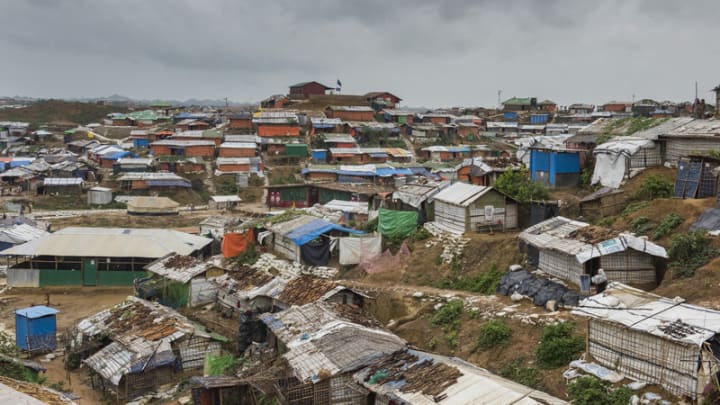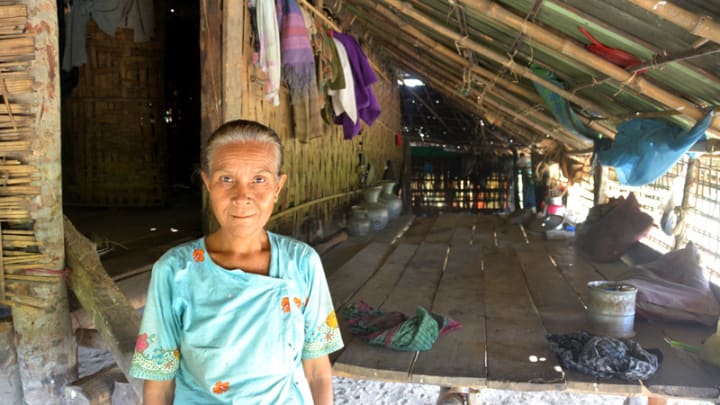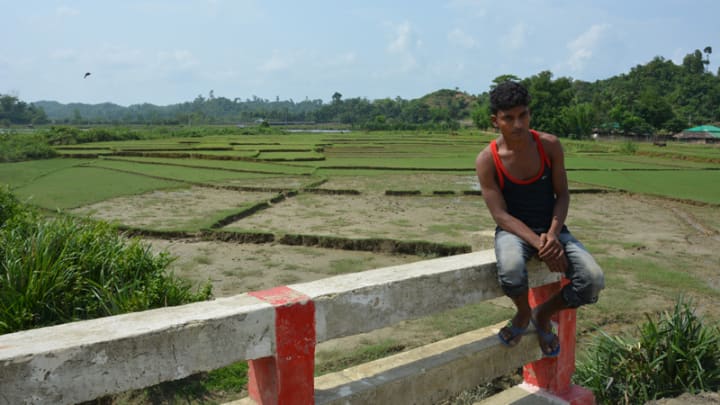
COX’S BAZAR, Bangladesh — Concrete replaces hand-dug mud steps zigzagging down steep hillsides. Sturdy bridges stretch over marshes, and a main road carves a bumpy path through once inaccessible zones. The mega-camp that sprawls across 6,000 acres of Bangladesh’s Ukhia region has changed greatly in the year since it became home to 700,000 additional Rohingya refugees fleeing violence and persecution in Myanmar’s Rakhine state.
For Rohingya and the aid groups that assist them, improved infrastructure and access represents hard-won progress. For the poor Bangladeshi communities on the camp’s fringes, it instills an alarming sense of permanence — one that could appear as support for Rohingya rather than their own families.
There are more than 100 projects underway targeting host communities, some of which were present before the mass arrival of Rohingya. Currently, 20,250 families receive livelihoods support, more than 25,000 participate in cash-for-work plans, and 2,150 families have received agriculture inputs training, according to the Inter Sector Coordination Group that oversees the Rohingya crisis response.
These numbers may mean little to hungry Bangladeshis, who watch trucks loaded with food and water turn from a road jammed with aid vehicles into Kutupalong camp: Away from them and toward their 1 million new neighbors.
More on Rohingya in Bangladesh:
► 3,000 Rohingya refugees train to tackle natural disasters
► In Bangladesh, aid groups confront an invisible danger
► In Rohingya camps, monsoon threatens hard-won WASH progress
The local communities have “set an admirable example to the rest of the world in their compassion and hospitality,” said International Organization for Migration Communications Officer Fiona MacGregor. But the influx has strained resources, infrastructure, public services, and the local economy.
As the reality of a protracted crisis settles over Cox’s Bazar, the development response for affected communities will require a longer term plan, experts tell Devex. Nearly one year after refugees made a terrifying journey across the border to safety, aid groups are looking harder at how their efforts can both reduce poverty and help establish social cohesion between Rohingya and Bangladeshis.

Life in Cox’s Bazar
Before they were dubbed “host communities” for 1 million refugees, communities in Cox’s Bazar were already poverty stricken. Now, with a population that has tripled in less than a year, life has gotten harder for most living in the region. Increased pressure on the environment means firewood is now scarce, while competition for labor makes paying jobs even rarer.
Prior to the influx, 1 in 5 households in the region south of Cox’s Bazar already had poor food consumption patterns, according to ISCG. On average, 33 percent lived below the poverty line while 17 percent lived below the extreme poverty line.
The arrival of a highly vulnerable population has served to exacerbate existing inequalities, according to Mir Ali Asgar, UNDP Cox’s Bazar program manager. Land owners who sell their produce and rice at local markets have hiked vegetable prices for a ballooning consumer base, while others now rent their land at a premium to NGOs establishing a presence in the area. The poor, meanwhile, remain poor.
“Work has gone down, but the price of rice hasn’t,” said 24-year-old Abdul Rahim, who lives in Amtali village in Whykong Union, now sandwiched between two refugee camps south of Cox’s Bazar. Rahim works as a carpenter, he told Devex, and he can often still rustle up enough work to get by — something many of his neighbors who relied on daily agricultural labor jobs now struggle to do.
Rohingya refugees are willing to work for a lower wage, explained UNDP’s Asgar. Last year, a day laborer could earn around 500 Bangladeshi taka ($5) for a job planting, weeding, or harvesting. Now, it’s closer to 300 taka.
Amtali is one village where UNDP recently conducted a cash-for-work road recuperation program, which hired 1,920 men and women to level and repair the damaged dirt road that leads from the main highway to their homes. Workers received 300 taka a day for three months of labor.
Small and medium infrastructure projects are at the top of the agency’s list as the type of income-generating activities they want to increase in the area, according to Asgar. Muhammad Joynal, a resident of Amtali who participated in rebuilding the road, told Devex the work was welcome, and he looks forward to future opportunities. But for now, he’s once again out of a job.
Such a drastic population increase has also put pressure on water and the surrounding habitat. Agricultural land near camps suffers from siltation and contamination from fecal matter, while thousands of forested acres have been cleared to make room for shelters. And Rohingya travel in groups, farther and farther from their camps to collect firewood to burn and sell, an income generation activity that local Bangladeshis also rely upon: “Previously we could go over there and collect firewood,” said Samia Singh, a lifelong resident of Amtali village, who pointed to a hill in the distance. “Now we have to buy it.”
About 700 tons of forest disappears each day due to firewood collection, according to estimates by ISCG. At this rate, “if we fail to supply alternative fuel for cooking, then all the forest in Ukhia will be lost by 2019,” said Md. Ali Kabir, a divisional forest officer in Cox’s Bazar who spoke at an information sharing meeting hosted by ISCG in May.
About 700 tons of forest disappears each day due to firewood collection, according to estimates by ISCG.
—Longer term environmental planning for restoring the degraded lands is underway, and will include watershed management and water resource mapping, according to ISCG. IOM is supporting nurseries to grow saplings and is already in conversation with the government’s forestry department to examine ways to support ongoing habitat rehabilitation, MacGregor told Devex.
To address the sensitive issue of firewood collection, the agency is also working with several other groups on a “major project” to provide liquid petroleum gas stoves to members of the host and refugee communities.

A cohesive future?
While there have been few conflicts between the two communities, aid groups fear tensions will rise as the crisis drags on, especially if host community needs aren’t prioritized.
“I would say the situation is still alright as long as we soon start planning on the broader needs,” said Sunee Singh, World Food Programme policy officer in Cox's Bazar, listing improved service delivery, infrastructure, and more widespread livelihood support, as immediate areas that deserve focus.
WFP has seen success with their women-focused livelihoods program, which has been active in the region since 2012 and works to enhance food security by helping women establish self-help groups to pool resources and collaborate on income-generating activities. The agency is now looking at how to integrate more technology transfer and skills training into their programs at the request of communities. But there’s still too much focus on small-scale farmers and businesses throughout the region — and not yet enough reach or effort toward building broader market linkages, Singh said.
The Rohingya and host community response is currently governed by a joint response plan, which targets 335,900 Bangladeshis in seven unions closest to refugee camps and champions development programs that benefit both host communities and refugees. Under the JRP, 20 percent of funding has been earmarked for projects to support the host community.
Still, as aid appears to pour into the camps, community members on the outskirts of the settlements, who once provided positive program feedback, are voicing their wish for additional support, Singh said.
“We recognize that anywhere in the world such situations can give rise to communal tensions over perceptions of disparity in services and distribution of aid and support,” IOM’s MacGregor told Devex.
Much of the disaster risk-reduction projects to prepare for severe weather, as well as infrastructure such as tube wells and roads, has benefitted both communities, MacGregor said. Health services, which have been severely strained throughout the region since the influx, are seeing a boost as groups prioritize improving services. New field hospitals and inpatient facilities within the camps have helped alleviate the burden on government facilities in recent months.
“As an example of how projects reach and serve both communities, we are seeing young mothers from the local community choosing to come and give birth in IOM health facilities inside the camps, as well as in the government clinics supported by IOM which largely serve the host communities,” MacGregor said.
But some of the seemingly positive acts — such as international NGOs and United Nations’ agencies hiring over 2,700 Bangladeshis since August 2017 — also have negative implications. The education system in Cox’s Bazar has suffered due to the hiring of both teachers and students to work on the refugee response, for example. Classrooms in the area count on one government-appointed head teacher along with an assistant teacher, who receive low pay and no benefits. Many assistants have left their positions in government-run schools in favor of employment — and a larger paycheck — with aid agencies in the camps.
There is no formal study to show how many teachers and students have left schools or colleges, but “a good number of college students also got opportunity to work in the camps, and their college education may delay or they may be permanently dropped out,” explained Sabrata Chakrabarty, livelihoods officer at the U.N. High Commissioner for Refugees.
Aid groups are hosting regular forums to facilitate dialogues about this issue and more, with community members, local leaders, and government officials. And U.N. Development Programme is in the process of planning a social cohesion project to bring together leaders from Rohingya and the community for culture sharing, open conversations, and to help link them with the local government system.
“How can we build harmony? If there is a chance of unrest, they can first come together, understand each other, and be able to solve their problems,” Asgar said.
In an effort to address the broader issue of jobs and market linkages, IOM is working with the Food and Agriculture Organization of the U.N. to support local farmers with tools such as mechanical tillers, seeds for nutritious vegetables, and organic fertilizer. In the future, it could allow local farmers to engage with WFP in supplying food for the refugee community — boosting local livelihoods and reducing the need to import food over long distances.
They are ambitious plans, especially when funding for the Rohingya crisis JRP — which calls for $950 million — stands at 33 percent funded: “With agencies struggling to finance basic life and death services in the camps, the opportunity to provide these hugely important projects for the host community are restricted,” MacGregor said.
In the meantime, Amtali village’s Samia Singh is hoping something can be done about the lack of water in her community. She spends one hour of her day collecting it from a pump far from her home, she said, often soaking towels in a bucket to bathe with so she can cut down on the number of trips she makes.
It leaves her frustrated: “They’re getting food. They’re getting everything. We’re left behind.”

